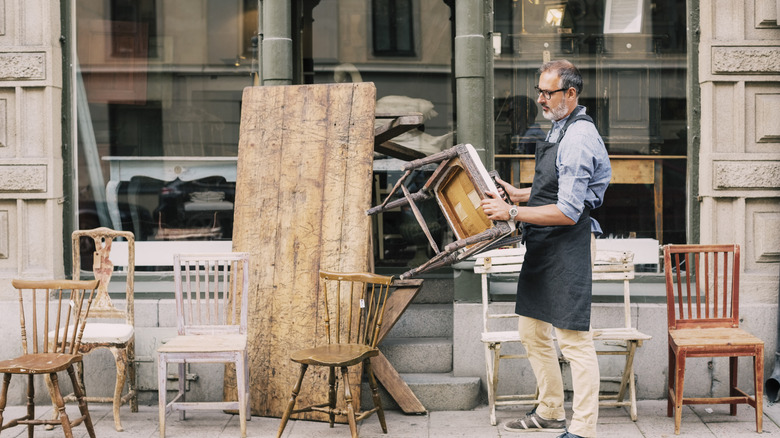Check All Your Thrifted Vintage Chairs - They May Be Hiding A Secret
Vintage chairs can add unique personality and an air of historical charm to your home. As a result, the furnishings have become treasured antique items that are dominating current thrifting trends. Whether you're searching for a cozy addition for a reading nook or shopping for a creative thrifted chair upcycling project, there are plenty of reasons to scope out the seats in your local second-hand shop. But some enthusiasts are urging shoppers to double check their vintage chairs, because there could be more to them than meets the eye.
While it's a common practice to breathe life into an outdated chair with new upholstery, many people don't consider that there could be an even older layer of fabric hiding underneath their chair's current upholstery. But a new social media trend is on the rise, where creators are double checking their vintage and antique chairs for relics from decades passed. In some cases, an added layer of fabric could mean the original upholstery is in decent condition, since it was less exposed to the wear and tear of daily life.
But if you're looking to further inspect your vintage chairs to see if they're concealing any hidden gems, you'll want to go about it with caution. Antique or vintage furniture can be extremely delicate, and should be handled with care to avoid any damage. Luckily there's a low-risk way to carefully inspect your chairs for a concealed layer of fabric, without compromising the upholstery.
How to check your vintage chairs for a hidden layer of upholstery
The most simple and straightforward way to check your thrifted chairs for a concealed layer of upholstery is by flipping them upside down and inspecting them for extra layers of fabric that are poking out. Trimmed edges of upholstery fabric are often visible when they're secured to the underside of a chair with nails or staples, so look for any unfamiliar fabric or patterns. This method is non-invasive, and since you're only using your eyes to inspect, it won't damage the furniture in any way.
If you aren't committed to the chair's current look, you can also check for underlying upholstery by using an X-Acto knife to gently cut a hole in the top layer of its fabric. Then, gingerly peek inside to see if there are any hidden gems underneath. It's important to note that this method will damage the top layer of fabric, and that vintage or antique upholstery can be difficult to restore. However, if you're planning on updating or reupholstering the furnishing anyways, it doesn't hurt to investigate before starting your project. If you do find a welcome surprise, you can use fabric scissors to carefully trim off the top layer, exposing the originally upholstery underneath.
